

This image has been combined with data from the James Webb Space Telescope (red, green, and blue).Ĭhandra’s data (purle) has been combined with information from NASA’s Imaging X-ray Polarimetry Explorer (light blue) as well as the Hubble Space Telescope (yellow) to provide astronomers with an unprecedented view of Vela, the aftermath of a star that collapsed and then exploded. The artistic impression shows NASAs planet-hunting Kepler spacecraft operating in a new mission profile called K2. This mission has been conceived by William Borucki and Dave Koch of NASA Ames Research Center, Moffett Field, Calif., and developed at NASA Ames. Chandra’s X-ray image (purple) captured hot gas that will eventually be pulled back into the black hole. The Kepler observatory was placed in an Earth-following orbit March 6, 2009. Similar to our own Milky Way, the center of spiral galaxy NGC 1365 contains a supermassive black hole that is being fed by a steady stream of material. In this case, the planet is not thought to be habitable.
#Nasa kepler movie#
Tatooine is the name of Luke Skywalker's home world in the science fiction movie Star Wars. The planet, called Kepler-16b, is the most 'Tatooine-like' planet yet found in our galaxy.

ESO’s Very Large Telescope (VLT) depicts the light from hydrogen atoms in red, along with optical and infrared data from the Hubble Space Telescope (orange and cyan). NASA's Kepler mission has discovered a world where two suns set over the horizon instead of just one. These tails are made of superheated gas that Chandra detects in X-rays (blue). ESO 137-001 is a galaxy that is moving through space at 1.5 million miles per hour, leaving two tails in its wake.


 0 kommentar(er)
0 kommentar(er)
